The best way to anticipate the needs of your future Chesapeake Bay Retriever puppy is if you start from predicting its growth. The Chesapeake Bay Retriever growth chart is, at times, a bit of a complex subject, especially because not all Chesapeake puppies grow the same.
Having a decent height and weight chart of your future puppy in front of you will most definitely solve a lot of dilemmas in the beginning.
How big does a puppy grow during its life stages, what can you expect in each of them, and how do you treat your pet since its early puppyhood stage are all questions that are answered in this article.
These canines, as old and as popular as they are, are not exactly the number one puppy of the family. Still, the breed makes an excellent family dog that is eager to play, please, and accompany their owner.
So, my advice for all Chessie enthusiasts (and owners) is to sit nicely, pour yourself a warm cup of coffee, and enjoy the read!
Chesapeake Bay Retriever Growth Chart
| Age | Weight | Height |
|---|---|---|
| Week 1 | 2-2.5 Ibs | 0.5 inches |
| Week 2 | 3 Ibs | 1-1.2 inches |
| Week 3 | 3-4 Ibs | 2 inches |
| Week 4 | 5-6 Ibs | 2-3 inches |
| Week 5 | 6-7 Ibs | 3-4 inches |
| Week 6 | 8-10 Ibs | 4-5 inches |
| Week 7 | 11-13 Ibs | 5-6 inches |
| Week 8 | 13-15 Ibs | 7 inches |
| 3 Months | 25-27 Ibs | 12.5 inches |
| 4 Months | 35-40 Ibs | 15-17 inches |
| 5 Months | 40-47 Ibs | 17-20 inches |
| 6 Months | 50-55 Ibs | 20-22 inches |
| 7 Months | 55-65 Ibs | 21-23 inches |
| 8 Months | 60-70 Ibs | 21-24 inches |
| 9 Months | 60-75 Ibs | 22.5-24 inches |
| 10 Months | 65-75 Ibs | 23-25 inches |
| 12 Months | 65-80 Ibs | 23-26 inches |
| 18 Months | 65-80 Ibs | 23-26 inches |
| Adult Chessie | 65-80 Ibs | 23-26 inches |
Chesapeake Bay Retriever Growth Stages
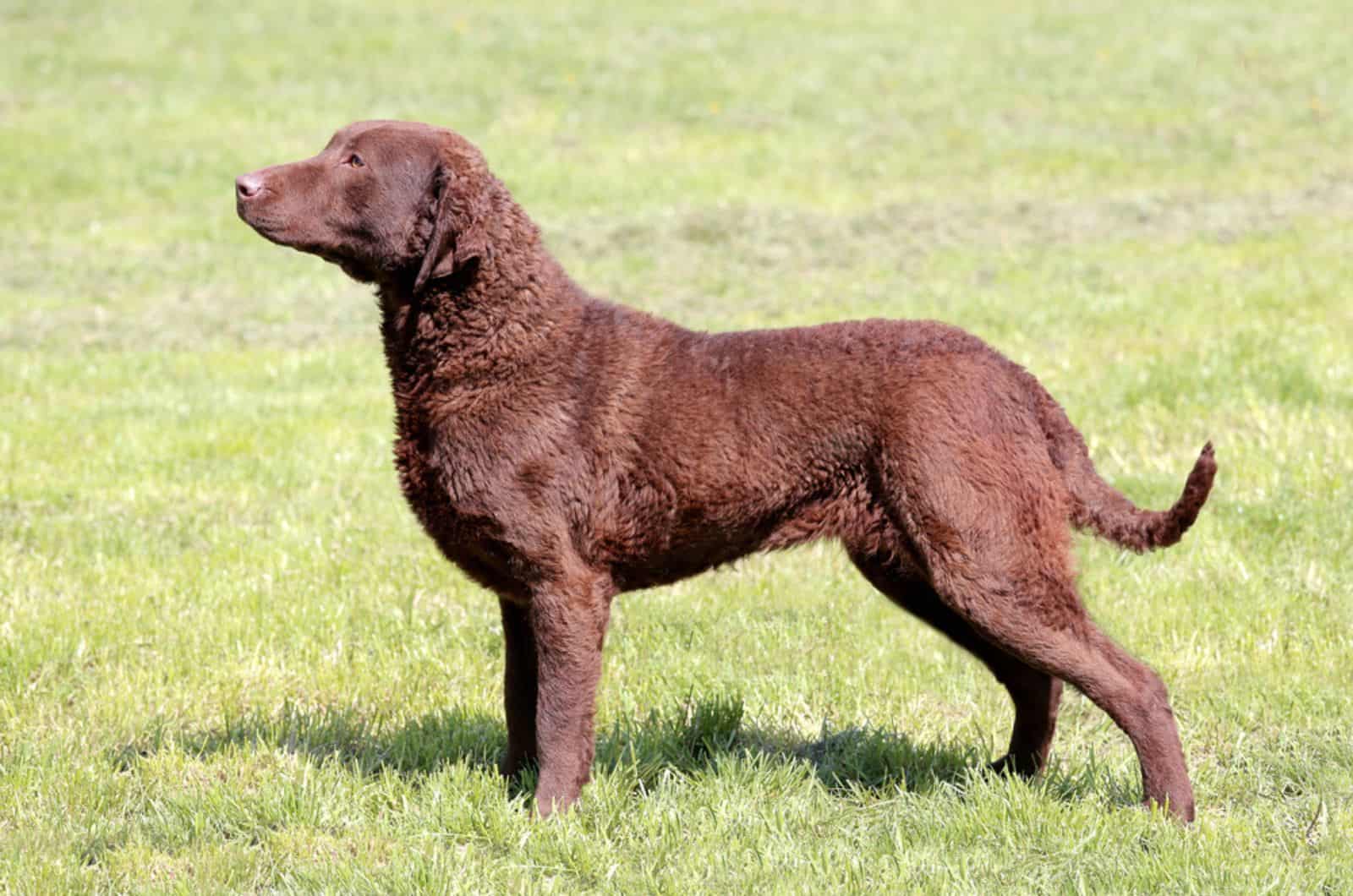
As we can see from the Chesapeake Bay Retriever growth chart above, the average weight of an adult Chessie revolves between 65 and 80 pounds. On the other hand, measured from the withers, the puppy is 23 to 26 inches tall.
Still, bear in mind that this is the estimated size of a puppy, which means that it can go up or down by a few pounds and inches, which is not worrying. However, a significant deviation from the estimated weight or height is a red flag that any dog owner should be aware of.
There are two things you can do on the initial basis. The first is to research the best Chessie breeders in the U.S. and buy a puppy from them. Early DNA tests, health exams, and proper socialization are the keys to a healthy puppy, and that’s what you will get from reputable breeders.
The second thing is owner-related. Every responsible owner should take good care of their puppies’ development. That said, you should measure your puppy’s weight and height on a daily basis during the first couple of weeks. Later on, doing it on a weekly or even a monthly basis will suffice.
Now, let’s see what exactly a Chesapeake Bay Retriever growth chart looks like throughout phases!
First Two Weeks
Here comes the early puppyhood stage! Excited much? You should be, as these are probably the most adorable moments of your puppy’s life.
However, as much as it looks adorable at first, you should be aware of the fact that newborn canines are fragile, weak, and incapable of maintaining their own body temperature.
Newborn litters should always be kept next to their mother, which provides them with heat and food.
Mother’s milk is the only food that newborn puppies are allowed to eat. Anything else, including cow milk, would be a huge mistake, as newborns are lactose intolerant, and they all have a sensitive stomach.
Newborn Chessies that don’t have the luxury of being next to their mom should be kept in 85 F to 90 F room temperature.
In this case scenario, milk replacers are the only reasonable solution. The weaning process doesn’t start until they start showing the first teething symptoms, which generally doesn’t happen until they turn two to three weeks of age.
Before the first teething symptoms, Chessie puppies start opening their eyes, and they experience their first rudimentary crawling. As their head is still too heavy to carry, expect to see a lot of failures in this regard. However, this is all normal, and not a cause for panic.
Puppies are usually fully capable of walking at three weeks of age. Alongside the first teething symptoms and the weaning process, the first Chessie steps are probably the most innocent sight that an owner can experience. From there on, it’s all about jumps and didoes.
From Three Weeks To Five Months
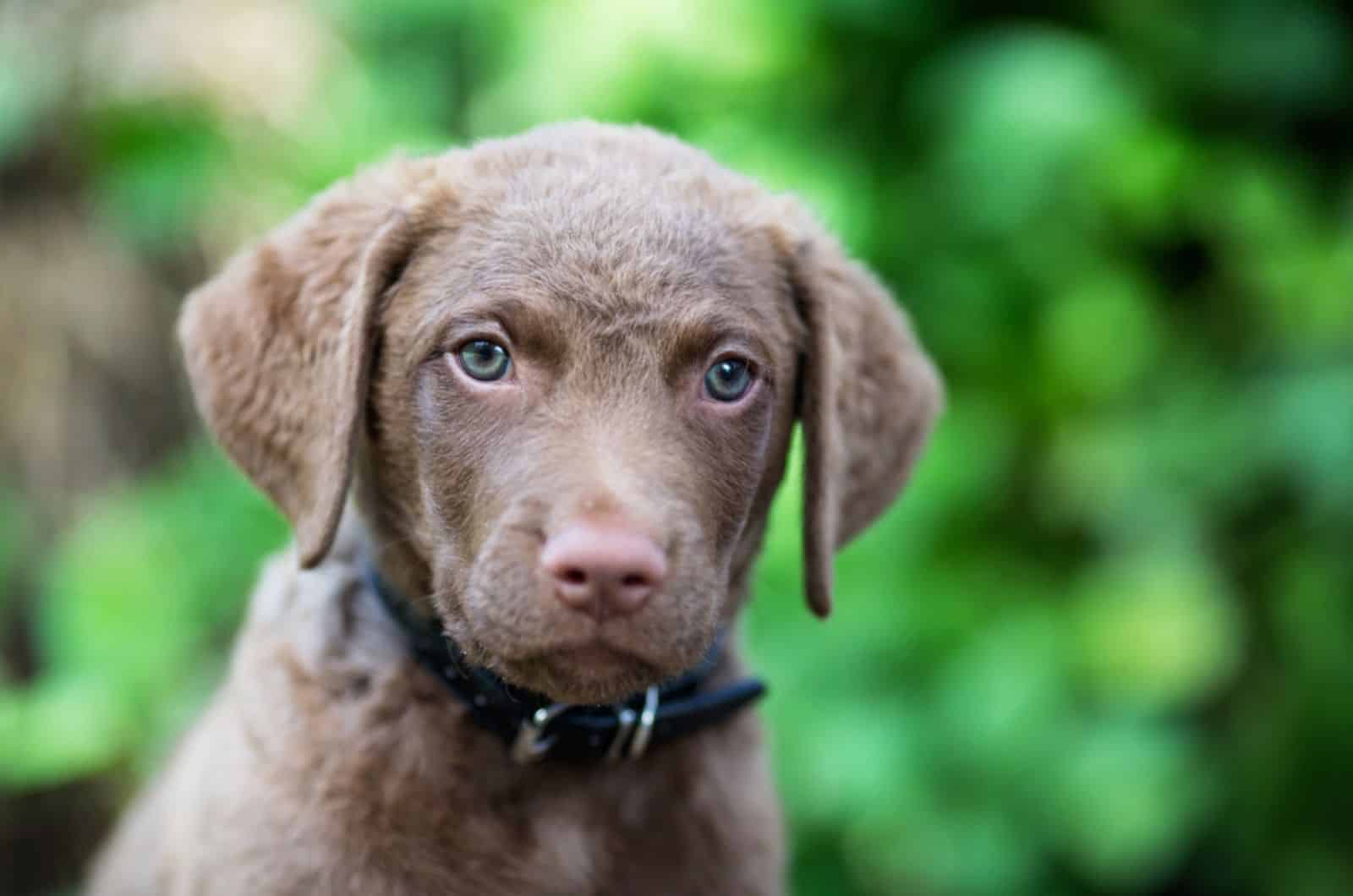
Even though three weeks of age is still considered to be the early puppyhood stage, bear in mind that Chessie canines are extremely active dogs, even in early puppyhood. With that being said, you should give a lot of attention to early socialization training.
Unlike other Retriever breeds, such as Labradors and Golden Retrievers, these canines are not exactly the best behaved puppies in the world. They are often mischievous and stubborn, and they just adore having their own way.
By teaching your puppy proper socialization and obedience manners, you will save hours, days, and even weeks of work in the latter stages.
At three to four weeks of age, a Chessie’s coat colors are fully recognizable and easy to distinguish, even though their eyes might still be bluish. Some of the colors that you can find in these American beauties are tan, brown, sedge, and deadgrass.
At eight weeks of age, puppies should be subjected to the real stuff. This includes intensive socialization, obedience training, potty training, and a daily exercise routine.
Still, bear in mind that these are still partially-developed puppies that don’t have the strength to exercise like adult dogs. Short runs in a back yard will be more than enough.
During this period of time, make sure your Chessie puppy eats the best-quality puppy food. Foods enriched with calcium, phosphorus, and protein will add strength to the bone structure and muscle development.
Still, not all littermates will develop equally, as some puppies take more time.
From Six To Twelve Months
In no time, your puppy will reach its adolescence. That’s right! At six months of age, you will start noticing the first sexual maturity symptoms in your dog.
Restlessness, humping anything that comes in its way or even anything that moves, rolling on the floor, and simply acting weird all of a sudden are the first symptoms that indicate sexual maturity in any dog.
This is exactly why you should consider spaying or neutering your dog between six and twelve months of age. Puppies under one year usually take less time to fully recover, which is not the case with fully-grown dogs.
The pain after neutering doesn’t last long (no more than a week), but make sure you provide a neutered puppy with silence and good care.
At six months of age, Chessie puppies are 50 to 55 pounds heavy, and 20 to 22 inches tall. At this age, puppies are mature enough to be gaining unnecessary weight, which is to be avoided. Quality food, alongside lots of exercise, will result in maintaining a healthy weight of your puppy.
On the contrary, you may deal with obesity, which is not a friend of any dog. In fact, obesity can be a trigger for a whole set of diseases in your Chessie such as bone fractures, diabetes, and heart disease.
If you have trouble sticking to your feeding chart, then taking medical advice from your vet is always a good idea.
From Twelve Months To Two Years
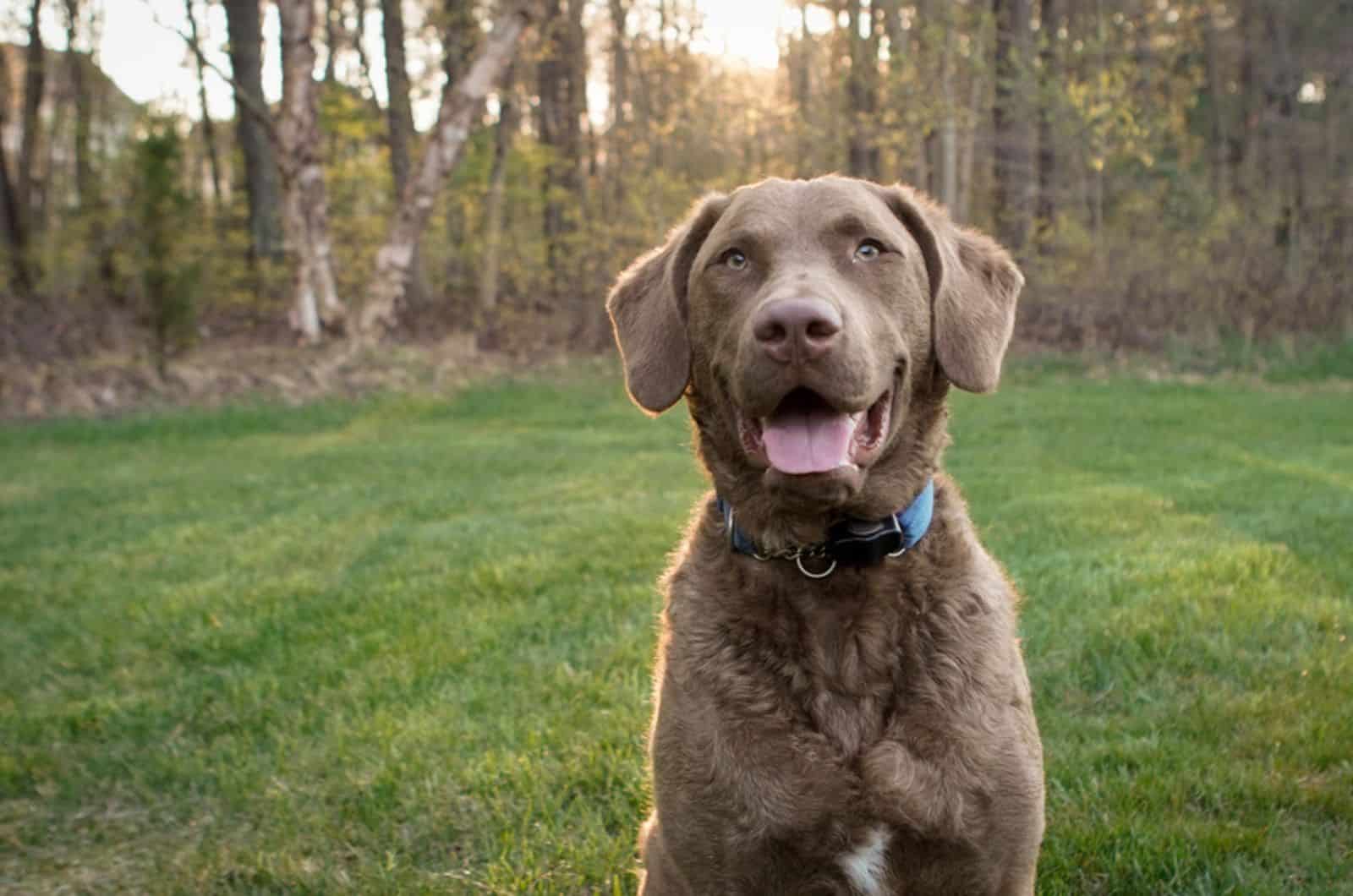
Many Chessies reach their full size at twelve months of age. That said, you can expect your Chessie to be 65 to 80 pounds in weight, and 23 to 26 inches tall before it turns two years of age.
However, physical maturity doesn’t necessarily mean that your puppy is mentally mature. In fact, many Chessie puppies don’t reach their mental maturity until they turn two years old. Still, female Chessies, just like all female dogs, usually get there faster.
Twelve months of age is considered to be a late puppyhood stage, as Chessies are still in their developmental phase of life. Their socialization process is not entirely done, which means that you still have a long way to go.
At this age, puppies crave activity and space, which is why you need to take them out on a daily basis. On the other hand, the use of positive reinforcement techniques, such as interactive dog toys or healthy snacks can be of huge benefit in terms of socialization training.
These canines are not recommended for inexperienced dog lovers, and at this age, you will realize why! Chessie dogs are not exactly the friendliest breed in the world, as they are always on alert, and they have the traits of a true watchdog.
This is why socialization is crucial during their puppyhood stage.
Adult Chessie
Chessies at two years of age are considered to be fully-developed adults. That said, they shouldn’t be under 60 pounds in weight, or under 22 to 23 inches in height.
If, by chance, your puppy is either underweight or underdeveloped, you should seek advice from your vet as soon as possible.
Sometimes, adult puppies are underdeveloped due to specific health problems such as hyperthyroidism, cancer, or some other autoimmune disease.
At two years of age, your puppy’s size chart should be properly monitored and supervised.
Excessive dog weight is usually triggered by an inadequate amount of food that your puppy receives on a daily basis. Unlike the puppy weight chart, the adult weight chart should be stable, unchangeable, and solid.
That said, you should stay away from poor-quality food brands, junk food, and unhealthy snacks. Instead, try providing your puppy with healthy home remedies and food enriched with green fibers.
That way, you will boost your puppy’s immune system and possibly avoid stomach torsion.
The adult food should be given to your pet at least twice a day. One meal on a daily basis is not recommended, as Chessies are prone to bloat.
Adult Chessies will need regular physical activity, which includes an hour of walking on a daily basis, and a spacious back yard. These canines don’t do well in closed spaces. Unlike smaller dog breeds, these puppies are not ideal for small apartments or studios.
When Do Chessies Become Seniors
As the average lifespan of a Chessie puppy revolves between 10 and 13 years, you can expect your Chessie to enter its senior years at eight or nine years of age.
This is an extremely sensitive period of life for any dog, which is why you should take into consideration its dietary needs, as well as its physical capability. A senior Chessie will still enjoy a daily walk, only now it should be reduced by at least thirty minutes.
A nice, gentle walk will help your canine remain healthy. On the other hand, senior Chessies will need less food, as their metabolism has gradually slowed down. That said, you should give them no more than three to three and a half cups of high-quality food a day.
Senior dogs that keep eating the exact amount of food they were eating during their adult phase may face gastric torsion. Unfortunately, gastric torsion (popularly known as bloat) can be fatal for senior dogs.
5 Factors Impacting The Chesapeake Bay Retriever Growth Chart
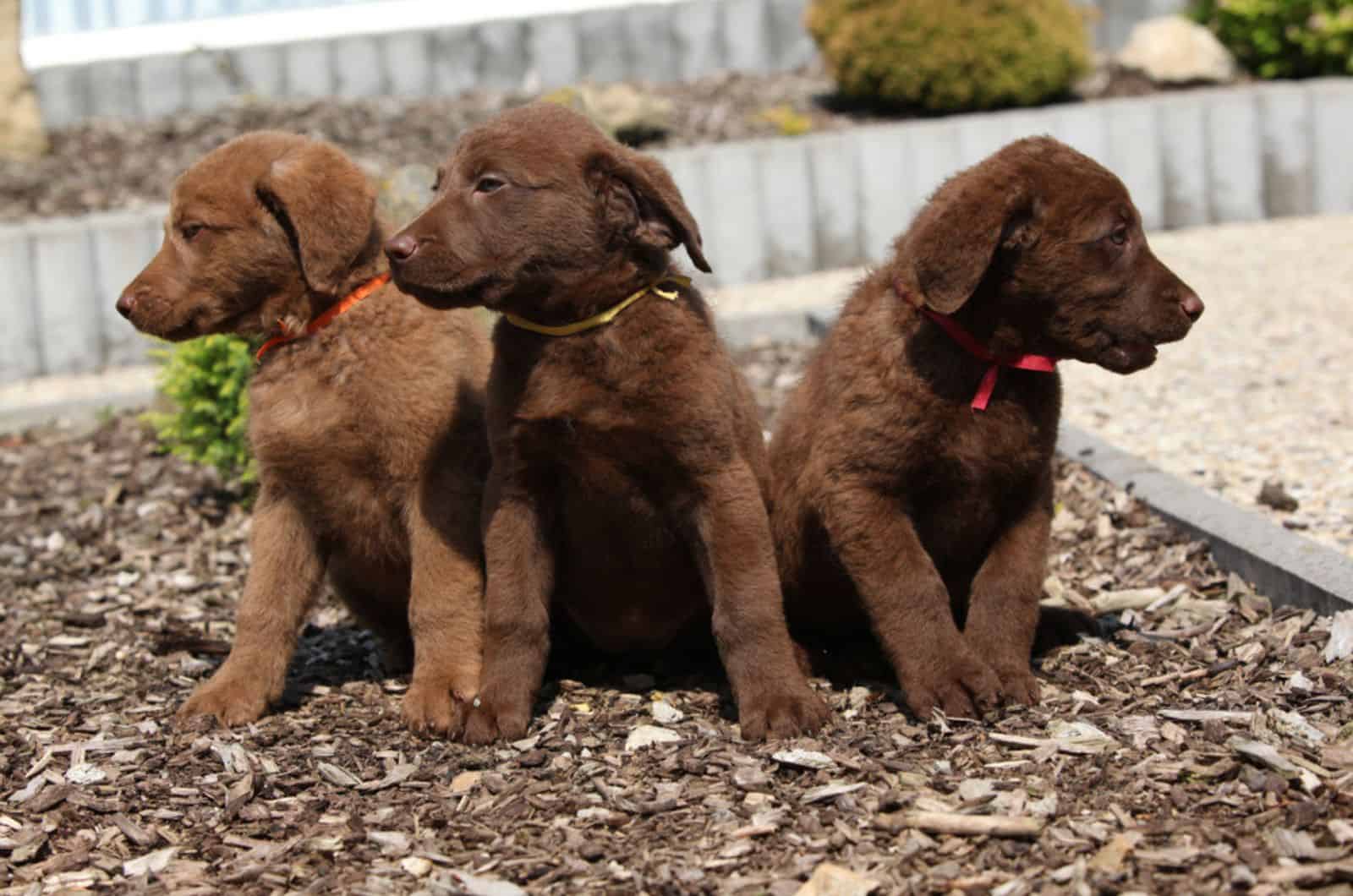
Not every Chessie grows the same. Some puppies take a lot more time to develop properly, while others reach their full size even before they turn twelve months of age.
There is more than one root to this phenomenon, which is why you don’t need to panic as soon as you notice some irregularities in your puppy’s growth.
Your part of the job is to keep your Chessie within the recommended numbers. That includes giving your pet proper dog food, subjecting it to regular daily exercise, and making sure your canine sleeps at least eight hours a day.
Despite not being among the twenty-two healthiest breeds in the world, Chessie canines are considered to be reasonably healthy dogs, with only a few health issues.
Still, their health can sometimes be one of the most impacting triggers for either overgrowth or underdevelopment.
Aside from their health, there are several other determinants that could affect the Chesapeake Bay Retriever growth chart. Those include genetics, exercise, dietary habits, and gender.
If you’re wondering: ‘‘Why is my Chesapeake Bay Retriever underweight?’’ – seek the answer in these five!
1. Health
Generally, the Chesapeake Bay Retriever growth chart is not affected by a puppy’s health, as these canines are healthy by default, and they don’t meet any significant health conditions.
However, some Chessie dogs may suffer from hip dysplasia and bloat.
Neither of these issues should represent a direct obstacle to their growth. Indirectly, puppies with hip dysplasia tend to be inactive, lethargic, and incapable of performing regular dog activities, which can be a trigger for excessive weight gain.
That’s why dogs with canine dysplasia should be monitored and provided with smaller portions of food, as keeping their weight healthy is (among other things) how they should be maintained.
Furthermore, some Chessie puppies may suffer from hypothyroidism, which can directly affect the puppy’s weight. Usually, dogs with hypothyroidism gain weight easily, and they become obese in no time.
Recognizing the first symptoms of a thyroid disorder is the key, as this autoimmune disease can leave fatal repercussions.
Unfortunately, this issue is not curable, but only treatable with hormone drugs. Still, if you subject your puppy to proper treatment, you can expect it to live a normal, happy life.
Another health concern related to Chessie puppies is progressive retinal atrophy. Even though the condition itself represents a gradual loss of vision, PRA doesn’t affect the puppy’s growth. Dogs facing PRA can normally live their life as long as they are properly nurtured.
2. Genetics
Even though we put this in second place, genetics is probably the most important determinant of the Chesapeake Bay Retriever growth chart. Naturally, these are activity-seeking, agility-equipped, big dogs with curly hair that qualify among large breeds.
Genetics is one of the main reasons why some Chessie puppies tend to either be bigger or smaller than their counterparts. Aside from their size, genetics determines their coat type, coat color, eye color, head shape, snout shape, body type, and ear shape.
In other words – genetics determines almost everything.
It is highly unrealistic to expect a Chessie’s offspring to be medium-sized or small-sized. On the other hand, an offspring of two smaller Chessies is highly unlikely to be a larger dog, as DNA plays a crucial part in its growth.
If you want to see what your future puppy may look like – take a good look at its parents first. Your newborn pet might carry a good deal of its parents’ traits, even behavioral ones.
However, genetics is not a reason to avoid proper upbringing. Acquired habits in dogs are just as important as genetics itself.
3. Exercise
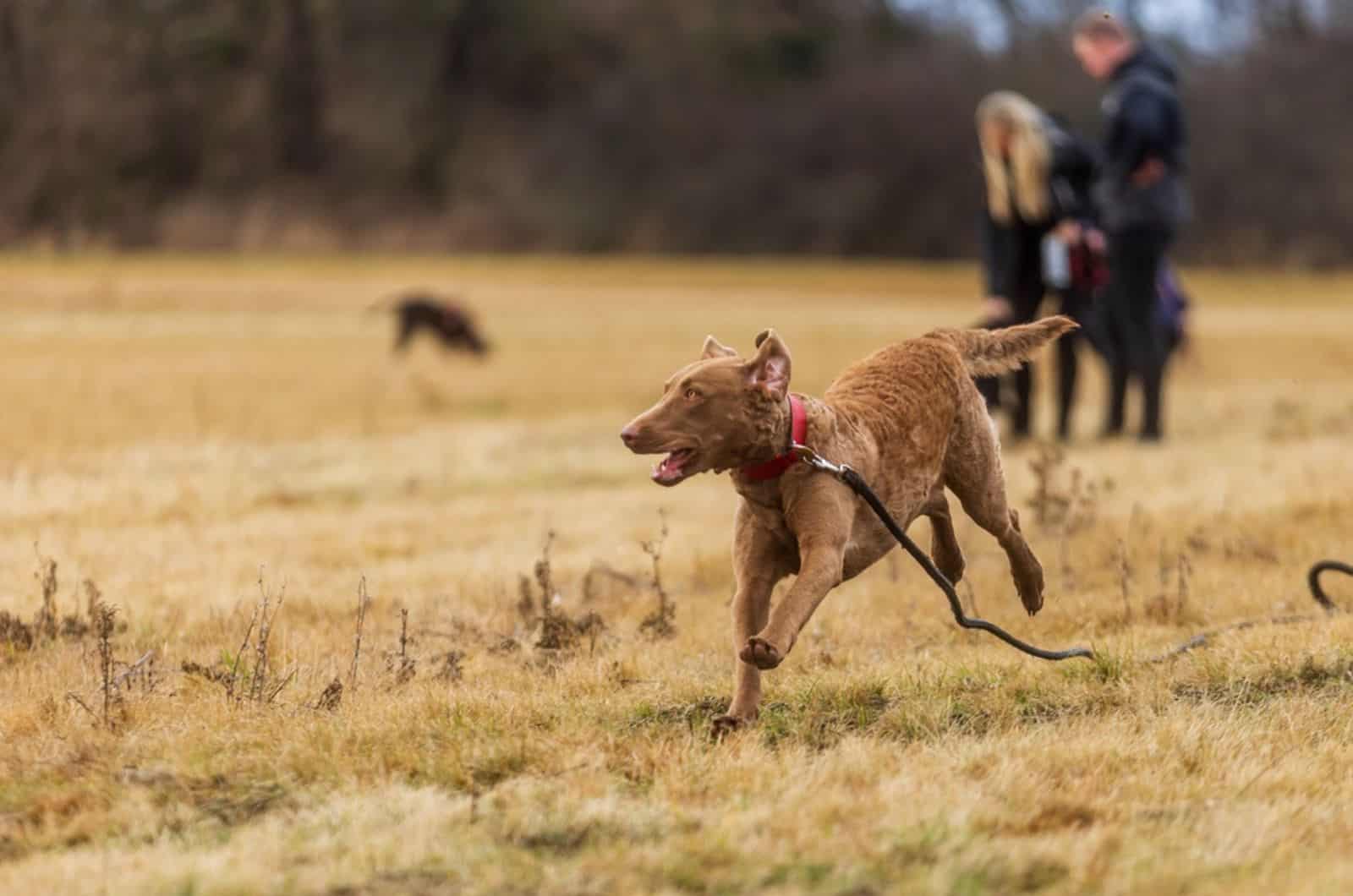
At times, exercise can play an important part in your puppy’s growth. In fact, the Chesapeake Bay Retriever growth chart positively correlates with the puppy’s exercise habits.
For instance, if your Chessie lacks exercise on a daily basis, and it still eats regular portions of food – you can expect it to gain weight pretty fast. On the other hand, excessive exercise and high-intensity training can lead to exhaustion, collapse, and weight loss.
In the long run, over-exercised dogs can face various bone and joint injuries, but that’s highly unlikely to happen. These canines are extremely athletic and agile, which puts them on top of the list of the most active dogs in the world.
On the other hand, exercise is important for your puppy’s mental health. Some studies show that the mental health of your puppy is in direct relationship with its growth. How so?
Simply… dogs that receive a proper amount of food, exercise, and affection are more likely to be mentally stable and happy.
On the other hand, neglected puppies are highly likely to lack mental health, which directly affects their eating and exercise habits. In the long run, their mental health is a trigger for excessive weight loss.
Even though this isn’t exactly the best family dog breed in the world, Chessie puppies still seek a lot of affection and love from their owner, as they give it all back in the same amount.
4. Dietary Habits
Indeed, dietary habits play an important role in the Chesapeake Bay Retriever growth chart. That’s why you should (aside from purchasing affordable pet food) take good care of your puppy’s feeding chart.
For starters, you should avoid junk food and table scraps. Even though this is an athletic dog breed by default, Chessie puppies, just like any other breed, can experience an unpleasant weight gain. Instead, try stimulating your dog with healthy snacks.
On the other hand, how much you feed your puppy is just as important as what you give it to eat. During their puppyhood stage, these canines should eat at least three to four times a day. Over time, you should reduce this number to only two times in their adulthood.
A Chessie’s dietary habits can be a trigger for both weight gain and weight loss. That’s why you should carefully design your dog’s feeding chart, and adapt it to the growth chart from this article.
In case you’re not experienced enough to do this – the best thing you can do is seek advice either from your vet or from a professional dog trainer.
5. Gender
Even though these canines are not exactly the tallest dogs in the world, male Chessies can be significantly taller than their female counterparts. In fact, adult females are expected to be shorter by several inches than male Chessies.
That said, a fully-grown female Chessie puppy is 21 to 24 inches tall. On the other hand, fully-grown males can reach up to 26 inches in height.
You can easily distinguish male Chessies from their female counterparts, even with an untrained eye. However, in some rare cases, female puppies can outgrow males by a few inches, which is mostly caused by genetics.
FAQ Section
1. How Fast Do Chesapeake Bay Retrievers Grow?
Generally, these canines are fast-growers. You can see an average Chessie puppy reach its adult size even before it turns twelve months of age.
However, these canines usually reach their full size at one to one and a half years of age. Still, just because they have reached their full size doesn’t mean that they are mentally mature as well.
Physical maturity and mental maturity in Chessie puppies is often characterized by a huge discrepancy. That’s why these canines are not considered to be adults until they reach two years of age.
On the other hand, their mischievous and childish behavior may remain years afterward. Proper socialization and obedience training are highly recommended in this regard, as untrained Chessies can be overwhelming.
In fact, the use of training tools, such as dog training collars and dog toys is highly encouraged.
2. What Is The Life Expectancy Of A Chesapeake Bay Retriever?
The average lifespan of a Chessie puppy revolves between 10 and 13 years. However, some Chessie dogs may live a lot longer, especially if they are properly nurtured and taken care of.
Unlike some other large breeds, such as Pitbulls, or dogs that look like them, these canines don’t meet many health issues, which adds to their overall lifespan. Still, some Chessie puppies may deal with canine dysplasia, stomach torsion, progressive retinal atrophy, and hypothyroidism.
3. Can A Chesapeake Bay Retriever Swim?
Indeed! These canines are excellent swimmers. The reason for this is rooted in their original purpose – Chessie dogs are known to be gundogs (or water dogs). They were originally used in the Chesapeake Bay for hunting and retrieving ducks from the water.
Even Chessies that serve as family dogs exclusively won’t mind an occasional swim. In fact, swimming is a great physical exercise that helps your puppy maintain its muscular body and good stamina.
Bear in mind that this is not a lazy dog breed, which is why you can use swimming alongside other activities to fulfill its activity needs.
Conclusion
The Chesapeake Bay Retriever growth chart is an important topic in your Chessie’s pet book. It can help you determine your puppy’s size throughout its life stages, which resolves a lot of dilemmas.
In fact, any responsible dog owner should be aware of his/her puppy’s growth potential, as knowing how big your dog will get can help you anticipate its needs in the future.
Conclusively, this is not a dog for small apartments, nor for families with smooth, easy-going lifestyles. On the contrary, these large dogs require an active owner with a spacious home and a big back yard.
If you happen to meet these criteria, then hurry up and get your Chessie companion right away!
Read more: Rough Collie Growth Chart: How Big Does Lassie Get?













